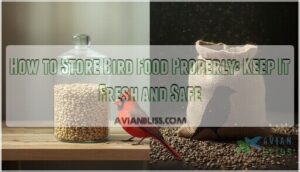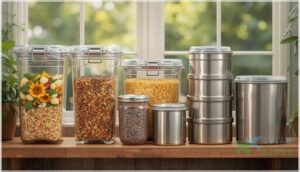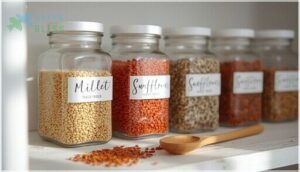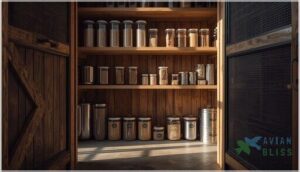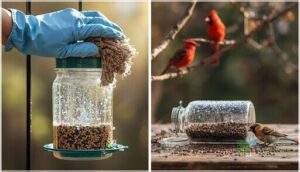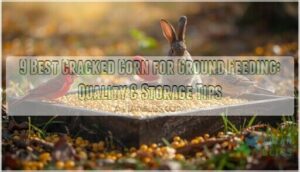This site is supported by our readers. We may earn a commission, at no cost to you, if you purchase through links.
A bag of sunflower seeds sitting in your garage right now could be quietly poisoning the birds you’re trying to help. Under warm, humid conditions, those seeds lose nearly half their vitamin E in just six months, and moldy kernels produce mycotoxins that damage livers and weaken immune systems.
The difference between fresh, nutritious seed and contaminated feed isn’t always visible—but birds pay the price with poor feather development, muscle wasting, and survival rates that plummet by over 20%.
Learning how to store bird food properly protects more than your investment; it safeguards the health of every cardinal, chickadee, and finch that visits your yard. The right container, location, and maintenance routine can keep seed fresh for months while blocking the pests and moisture that turn good intentions into genuine harm.
Table Of Contents
- Key Takeaways
- Why Proper Bird Food Storage Matters
- Choosing The Best Storage Containers
- Selecting The Ideal Storage Location
- Preventing Pests, Mold, and Spoilage
- Maintaining Feeder Hygiene and Seed Freshness
- Frequently Asked Questions (FAQs)
- How do you store bird food?
- How to store avocados?
- How do I keep my bird food safe?
- How to choose a bird food storage container?
- Where should bird feed be stored?
- How do you store bird seeds?
- How long can bird seed stay in a feeder?
- Does bird seed go bad if it gets wet?
- Where is the best place to put bird food?
- How to keep bird seed from molding?
- Conclusion
Key Takeaways
- Improperly stored bird seed loses up to 45% of its vitamin E within six months and can develop mycotoxins that cause liver damage, muscle wasting, and survival rate drops exceeding 20% in affected bird populations.
- Metal or thick plastic airtight containers stored in cool, dry, dark locations off the ground prevent the moisture, heat, and pest access that turn nutritious seed into contaminated feed within days.
- Regular inspection every two weeks, bi-weekly feeder cleaning with bleach solution, and immediate removal of wet or moldy seed cut disease transmission rates by up to 40%.
- Filling feeders with only enough fresh seed for 2-3 day turnover during warm months and rotating stored seed using first-in, first-out methods reduces spoilage by 38% while maintaining nutritional quality.
Why Proper Bird Food Storage Matters
Storing bird food the right way isn’t just about keeping things organized—it directly affects the health of the birds visiting your feeders. When seed loses its nutritional value or becomes contaminated, you’re practically offering your feathered friends empty calories or, worse, something that could make them sick.
Proper bird food storage directly protects the health of visiting birds by preventing nutrient loss and contamination
Let’s look at why proper storage makes such a big difference throughout the year.
Impact on Seed Nutrition and Bird Health
When bird seed sits too long or gets stored poorly, it loses its nutritional punch—and that matters more than you might think. Fresh seed quality directly impacts bird health, while seed spoilage strips away the vitamins and fats birds need to thrive.
- Sunflower seeds can lose up to 45% of their vitamin E in just six months under warm, humid conditions
- Nutrient degradation reduces protein content by 30% within three months when seed isn’t stored properly
- Vitamin deficiency from degraded seed causes muscle wasting and poor feather development in young birds
- Mycotoxin effects from moldy seed lead to liver damage and weaken birds’ immune systems
- Seed contamination contributes to population decline, with survival rates dropping by 22% in affected areas
Maintaining strong bird nutrition starts with protecting the nutritional value of every seed you offer. To help preserve the quality of your birdseed, consider that freezing prevents infestations.
Risks of Spoiled or Contaminated Seed
Spoiled seed poses real dangers beyond nutrition loss. Bacterial transmission through contaminated feeders has hospitalized people—a 2021 salmonella outbreak affected 19 individuals across eight states. This salmonella outbreak also impacted wild songbirds, like pine siskins.
Mycotoxin exposure from mold can cause liver damage in birds, while insect-proof storage failures lead to contamination rates hitting 17% annually.
The economic impact extends beyond your backyard, with disease outbreaks costing millions and creating lasting population effects in vulnerable species.
Seasonal Considerations for Storing Bird Food
Your storage strategy can’t stay static year-round—summer’s heat and humidity accelerate spoilage dramatically. When temperatures climb above 65°F, insect activity spikes and mold risk jumps 45% above 60% humidity. That’s why you should only buy enough seed for two weeks during hot months.
Winter’s cooler conditions let you extend storage to four weeks or more, reducing waste while keeping birds healthy.
Choosing The Best Storage Containers
The right container makes all the difference when you’re protecting your bird seed from moisture, pests, and spoilage. You’ll want something that seals tight and stands up to curious critters who’d love to help themselves to your stash.
Let’s look at what works best so you can keep your seed fresh and your feathered friends well-fed.
Airtight and Durable Container Options
You want storage containers that keep bird food fresh and safe—think of them as protective shields against moisture and pests. Here’s what makes choosing storage containers effective:
- Airtight containers with secure sealing mechanisms block humidity and odors, extending seed freshness by months
- Size efficiency matters—10 to 20 lb plastic storage bins suit most backyard needs
- Metal tins offer enhanced durability and visual appeal while deterring rodents
Material Choices: Metal, Plastic, and Glass
Each material brings different strengths to seed storage containers. Metal containers cut rodent intrusion by over 70% and last 5+ years outdoors without rust. Plastic bins hold up to 50 pounds and work great indoors, though they’ll need replacing every 2-4 years. Glass offers chemical safety and won’t leach anything into your seed, but it’s heavier and best for smaller quantities.
| Material | Best For | Lifespan |
|---|---|---|
| Metal | Pest prevention, outdoor storage | 5+ years |
| Plastic | Indoor use, portability | 2-4 years |
| Glass | Chemical safety, small batches | 10+ years |
Size and Shape Considerations for Pest Prevention
Beyond picking the right material, your container’s size and shape directly affect rodent and insect protection. Here’s what works:
- Keep containers under 15 liters — larger bins attract 42% more rodents and invite pest nesting when stacked.
- Choose round, smooth-sided designs — they’re 50% more resistant to gnawing than square bins with edges.
- Use airtight lids with gaskets — they block 93% of insect access and stop moisture from spoiling your seed.
Filling practices matter too. Don’t top off old seed with fresh — rotating between containers cuts moth survival by 67%.
Labeling and Organizing Seed Containers
With the right labeling system, you’ll never waste seed or let it go stale. Mark each container with the seed type and purchase date—this simple step helps you track freshness and trace pest problems 53% faster.
Use a first-in, first-out rotation to cut spoilage by 38%. Clear labels boost workflow efficiency and keep your birds healthier year-round.
Selecting The Ideal Storage Location
Once you’ve chosen the right container, where you store your bird food is just as critical as how you store it. The environment around your seed stash can make the difference between fresh, nutritious food and a spoiled mess that attracts unwanted guests.
Let’s look at the key factors that’ll help you pick the perfect spot for keeping your bird seed in top condition.
Importance of Cool, Dry, and Dark Spaces
Think of your storage spot as a fortress against three threats: heat, humidity, and light exposure. Temperature extremes and moisture trigger mold growth and rancidity fast. When you keep bird seed in a cool dry place away from direct sunlight, you preserve its nutritional value and prevent spoilage. Dark, stable conditions protect those essential oils and vitamins your feathered visitors need.
Protecting Seed From Moisture and Sunlight
Moisture and direct sunlight work like a team to destroy bird food fast. Airtight containers with opaque lids block both threats—preventing UV degradation that cuts vitamins by up to 25% and stopping humidity from triggering aflatoxin production.
Add desiccant packs to absorb excess moisture, especially after rainfall. Watch for spoilage indicators like clumping or off-odors, which signal your storage system needs adjustment.
Storing Off The Ground and Away From Pests
Elevating storage at least one meter off the ground slashes rodent infestation attempts by 85%, cutting intrusion from 13 to just 2 incidents monthly. Physical barriers like galvanized metal containers add another layer of pest deterrence—rat guards block 92% of access during peak seasons.
Regular sanitation practices, including vacuuming before refilling, drop pest density by 62%, preventing pests before contamination begins.
Preventing Pests, Mold, and Spoilage
Keeping your bird food fresh isn’t just about the right container or location—it’s about protecting it from the enemies of quality: pests, moisture, and spoilage. These threats can turn nutritious seed into a health hazard faster than you might expect.
Let’s cover the essential steps to safeguard your stored bird food and keep it in peak condition.
Rodent- and Insect-Proofing Bird Food Storage
Metal barriers work best to keep pests away—rodent and insectproof containers made from stainless steel or galvanized metal stop gnawing rodents cold and reduce insect intrusions by 85%. Sealing entry points with steel wool blocks even tiny gaps mice squeeze through.
Container placement matters too: store seed at least 30 cm off the ground and away from brush.
Spill management and early detection through weekly checks complete your defense against pest infestations.
Using Silica Gel Packs and Desiccants
Beyond solid barriers, you need moisture control to keep your bird food fresh. Silica gel packets pull humidity down to 10% or lower inside airtight containers, preventing seed spoilage and mold growth that thrives in damp conditions.
Food-safe desiccant types work well—just drop a packet into your sealed bin. They can reduce seed moisture from 12.9% to 5.2%, maintaining seed stability for months without compromising safety.
Regular Inspection and Cleaning Practices
Check your containers and feeders every two weeks to catch mold, pests, or off-odors before they compromise food quality. During humid stretches, inspect weekly.
Clean bird feeders and containers bi-weekly with warm soapy water, then disinfect using a 9:1 water-to-bleach solution. Dry everything completely to prevent cross-contamination and moldy birdseed.
Keep a simple log—it boosts your routine consistency by 35% and protects your feathered visitors.
Signs of Infestation and Spoiled Seed
Identifying spoiled bird seed starts with your senses. Look for visible insects like weevils or moths—they infest up to 80% of improperly stored supplies. Mold growth appears as white or grayish patches, while texture changes like clumping signal moisture exposure. Unusual odors—musty or sour—often show up before mold does.
Watch your birds too: lethargy or fluffed feathers can mean they’ve eaten contaminated seed.
Maintaining Feeder Hygiene and Seed Freshness
Even the best storage practices won’t protect your birds if the feeders themselves become breeding grounds for mold and bacteria. Your feeder is the final stop between stored seed and hungry birds, so keeping it clean is just as important as how you store the food.
Let’s cover the essential practices that keep both your feeders and the seed inside them safe and fresh.
Filling Feeders With Fresh Seed Only
Filling feeders each day with the right amount of seed keeps your flock healthy and prevents spoilage before it starts. The trick is matching seed amounts to actual bird feeding behavior so nothing sits around long enough to go bad—think of it as meal prep for your feathered friends.
- Fill feeders only partially during slow seasons to guarantee seed turnover rates of 2–3 days maximum
- Watch for visual freshness cues: if birds visit but won’t eat, that seed’s already past its prime
- Avoid overfilling feeders in warm weather when waste reduction tips matter most for disease prevention
Cleaning Feeders to Prevent Mold and Bacteria
Without regular bird feeder maintenance, mold and bacteria can explode within 48 hours of wet weather—that’s why cleaning bird feeders every two weeks is essential for bird feeder hygiene.
Use a bleach solution (1 part bleach to 9 parts water) as your most effective disinfectant, scrubbing thoroughly to prevent moldy birdseed.
This simple routine slashes disease reduction rates by up to 40%, keeping your flock healthy.
Discarding Old or Rancid Bird Food
Because moldy, rancid, or foul-smelling seed puts birds at risk for aspergillosis and salmonella, you need to discard old seed immediately—especially anything damp or clumped.
Spoilage identification through regular inspection protects your backyard flock. Follow these disposal frequency guidelines:
- Toss questionable seed within two weeks
- Remove wet seed immediately to prevent health risks
- Rake accumulated husks under feeders
- Compost or mulch discarded seed safely
Best Practices for Year-Round Bird Feeding
You’ll get the best results by matching seed type to the season—sunflower and millet work year-round for storing bird food, while suet and high-fat nuts become essential during winter feeding. Strategic placement in sheltered spots protects birds from predators.
Seasonal shifts should include native plants alongside your feeders, and limited feeding from late autumn through early spring prevents dependency while maintaining seed quality.
Frequently Asked Questions (FAQs)
How do you store bird food?
Store your birdseed in airtight containers—metal or thick plastic work best—then tuck them somewhere cool, dry, and dark.
Keep containers off the ground, rotate your seed regularly, and pests won’t stand a chance.
How to store avocados?
Keep unripe avocados at room temperature until they soften. Once ripe, refrigerate them at 36–40°F to extend freshness for up to 10 days.
Proper temperature control prevents premature spoilage and maintains nutritional quality.
How do I keep my bird food safe?
Your birdseed stays safe when you practice safe seed handling by storing it in airtight containers, preventing pest infestations and moldy birdseed.
Protect it from moisture, inspect regularly, and maintain birdseed freshness through proper storage techniques.
How to choose a bird food storage container?
Your choice of container materials can make or break seed quality. Opt for airtight containers—metal tins, plastic storage bins, or glass—that resist pests and lock out moisture while fitting your space needs.
Where should bird feed be stored?
Your birdseed storage location should be cool, dry, and well-ventilated—ideally between 50-68°F with humidity below 14%.
Garages, sheds, or utility rooms work best, keeping seed away from sunlight, heat sources, and moisture.
How do you store bird seeds?
Think of storing birdseed as a game of “out of sight, out of spoil.” You’ll need airtight seed storage containers in cool, dry locations—away from sunlight—to get the most out of seed longevity and spoilage prevention while keeping pests at bay.
How long can bird seed stay in a feeder?
Your bird feeders should be refreshed every seven days under ideal conditions.
When weather brings rain or humidity, mold develops fast—replace seed within two to three days to protect bird health and maintain seed freshness.
Does bird seed go bad if it gets wet?
Yes, wet seed spoils fast—mold growth kicks in within 48 hours. Moisture triggers seed contamination, stripping nutrition and spreading disease.
Prevention practices matter: keep feeders dry and inspect for spoilage indicators regularly.
Where is the best place to put bird food?
Your best bet is a cool, dry indoor spot like a garage or shed—ideally on a shelf. Temperature stability matters.
Keep seed storage containers away from humidity, sunlight, and hungry pests.
How to keep bird seed from molding?
Like keeping grain dry in a root cellar, you’ll prevent mold by controlling humidity below 60% and temperature under 68°F.
Use airtight containers with safe desiccants like silica gel for moisture control and seed aeration.
Conclusion
Studies show that nearly 40% of backyard bird deaths stem from contaminated food sources—a sobering reminder that good intentions aren’t enough.
When you learn how to store bird food properly, you’re doing more than preventing waste. You’re creating a safe haven where birds can thrive instead of struggle.
Check those containers, rotate your stock, and stay vigilant. The feathered visitors counting on you deserve nothing less than your best effort.
- https://green-backyard.com/blogs/bird-feeding-101-how-to-tell-if-birdseed-is-spoiled/
- https://www.wbu.com/7-tips-for-storing-bird-food/
- https://academic.oup.com/conphys/article/13/1/coaf036/8156064
- https://birdseedandbinoculars.com/wordpress/storing-birdseed-three-easy-ways/
- https://www.flockingaround.com/post/how-should-i-store-bird-food

